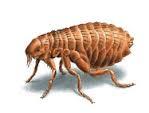Flea Control Information
Description
Flea Control
 Fleas are small, dark brown or reddish brown, from 1 to 4 mm long, with flattened bodies. They are wingless and can jump up to 20 cm vertically and 41 cm horizontally.
Fleas are small, dark brown or reddish brown, from 1 to 4 mm long, with flattened bodies. They are wingless and can jump up to 20 cm vertically and 41 cm horizontally.
Fleas have four stages of development: egg, larval, pupal and adult. It takes from 2 weeks to several months to go from egg to adult depending on the species, temperature, humidity and food availability. After each blood meal, females lay 4 to 8 smooth, round, light-colored, sticky eggs. She can lay 25 eggs per day, and roughly 800 in her life. Eggs hatch into very small, hairy, worm-like larvae that are whitish with brownish heads. The larvae are from 1.5 mm to 5 mm long. They feed on organic debris, their own cast skins, and dried blood in adult flea excrement. Larvae can survive up to 200 days even in unfavorable conditions and travel up to 30 cm per minute. They will spin silken cocoons covered with particles of dust, fibers, sand, and organic debris and later emerge as an adult flea. Adult fleas may remain in the cocoon for several months until favorable conditions arise, such as a rise in temperature and carbon dioxide levels. Vibrations created by the presence of humans and pets will also stimulate their emergence and activity.
What can they do?
Unlike some pests that can be found around the home, fleas cause discomfort and irritation to both pets and people. Fleas are not just an annoyance, some people and animals suffer allergic reactions to flea saliva resulting in rashes. Flea bites create a small, hard, red, itchy spot, slightly-raised and swollen with a single puncture point at the center. The bites often appear in clusters or lines and can remain itchy and inflamed for up to several weeks. Fleas can also lead to hair loss as a result of frequent scratching and biting by the animal and can cause anemia in extreme cases.
Besides these problems, fleas can also transmit disease. For example, fleas transmitted the bubonic plague between rodents and humans by carrying bacteria. Endemic typhus fever, and in some cases tapeworm can also be transmitted by fleas.
Fleas usually feed several times a day but can survive several weeks without a meal. Adult fleas usually leave the host after feeding; however, flea eggs, larvae or pupae may be found on pets. The peak season for flea infestations outdoors in most parts of Canada is from early August to early October. In excessively dry, hot summers fleas tend to dehydrate and die.
More Information and Tips on Fleas Extermination / Control:
- Fleas are small, dark brown or reddish brown insects
- 1 - 4 mm with flattened bodies
- Wingless, but can jump up to 20 cm(8 inches) vertically and 41 cm (16 inches) horizontally
- Four stages of development - egg, larval, pupal, adult
- Females lay 4 - 8 smooth, round, light-colored, sticky eggs after each blood meal
- Can lay 25 per day and 800 in her life span
- Eggs hatch into tiny (1.5 - 5 mm long), hairy worm-like larvae with whitish to brown heads
- Larvae feed on organic debris including their own shed skin and adult excrement
- Can survive up to 200 days
- Avel up to 30 cm (12 inches) per minute
- Spin silken cocoons covered in dust, sand, and debris - later emerging as an adult flea
- Bites cause irritation and discomfort to pets and people
- Some people and pets can have allergic reactions to the flea saliva left when bitten
- Bites leave a small hard, red, swollen, itchy spot with a single puncture at the center
- Bites are often in clusters or lines that can remain inflamed for weeks
- Bites can cause hair loss in animals due to excessive scratching
- Fleas can transmit disease or tapeworm but it is rare
- Fleas feed several times a day but can survive several weeks without a meal
- Fleas leave the host after biting but eggs, larvae or pupae may remain on the animal
- Peak season is August to October
- Pets and homes must be treated simultaneously to be effective
- Bad infestations may require more than 1 treatment
- If an Interior treatment is required, all people and pets must vacate the premises for 4 - 6 hours
Details
| Date Added | 2015-03-31 |
| Product Id | 10276734 |






